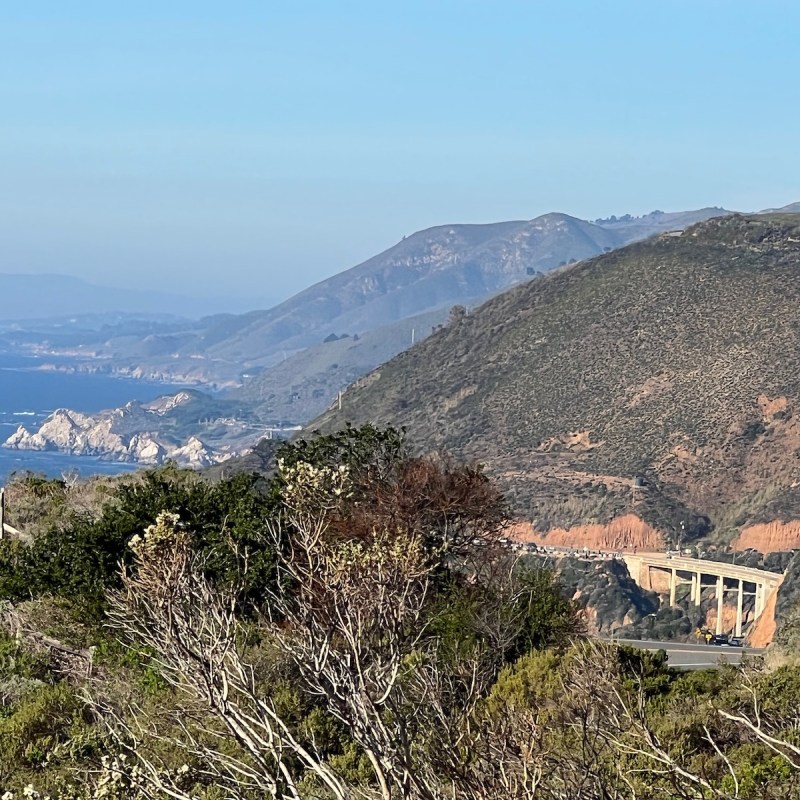
California Highway 1 along the Big Sur coast is an iconic location you’ve seen in movies, television shows, and pictures. Perhaps the most-traveled section is from Monterey to the town of Big Sur, a distance of about 35 miles one way. The most recognizable stop is the 1932 Bixby Bridge with its high concrete arches that hold the bridge across a canyon. Tourists from all over the world come to take pictures there and at other pull-outs along the road.
Videos by TravelAwaits
The rugged coast is photogenic and magnificent. There are a number of spots that might not be on your radar that I came to know while I spent 4 months living in Big Sur. Here are nine beautiful gems along California 101.

1. Henry Miller Memorial Library
The famous author lived in this home in Big Sur. Today, there is a small venue that celebrates his writing but also showcases live music and arts events in this very eclectic space. Walk in and enjoy whatever art is showcased at the moment and enjoy the bookstore, featuring the namesake author. Spend time outside under the trees and there may be live music underway. Visiting is free, but special events require tickets.

2. Pfeiffer Big Sur State Park
This beautiful park sits within a coastal redwood forest and the Big Sur River runs through it. There are great trails of a mile or less near the day-use area (entry fee is $10 per car). Other longer trails are several miles in length with significant elevation gains and can be accessed from the park. Pfeiffer Falls is on one of the short trails and is easy to walk, though there is elevation gain to get to the top. Spectacular views can be had by branching off on the Valley View Trail. Plenty of wildlife may be seen in the park including cantankerous wild turkeys! Stop by the nature center (free) to learn about the coastal redwoods, birds, animals, and the settlers from the late 1800s. Be sure to see the Colonial Tree — the largest redwood in the park. The Big Sur Lodge, restaurant, and camp store are located within the park.
3. Pfeiffer Beach
One mile north of the state park is the beach turnoff at Sycamore Canyon Road. This is a narrow, steep, and eventually, one-lane road that leads to Pfeiffer Beach. The U.S. Forest Service runs the area. There is a $12 entry fee for the day-use area (no national park pass discounts apply). There is parking at the base of the road (no trailers or motorhomes) and a trail that descends to the beach. The highlight of this location is the purple sand. Manganese garnet flows from the hills that meet the ocean, giving the sand its purple hue. Be sure to know the tide charts when you visit. Coastlines can be treacherous at high tide because of the rocky terrain.

4. Point Sur Lighthouse
The lighthouse rock point can be seen clearly from the road. It rises out of the sea and the waves crash all around it. You can see the lightkeeper’s house and water tower on top of the point. The lighthouse sits on top of a building and the light structure is only 40 feet tall. It faces the ocean and cannot be seen from the road. It has been in continuous operation since 1889 and sits next to the now-closed Point Sur Naval Facility. The Point Sur Lighthouse property can only be visited while on an official 3-hour walking tour ($15). Tours are given only on designated days and there are no reservations. You’ll park inside the locked entrance gate when the guide comes. You’ll ascend the winding road by tram or van, and once on the rocky point, there is a mile walk to the buildings and the walking tour. You can elect to climb to the top of the lighthouse for spectacular views or enjoy great views from the base.

5. Garrapata State Park
Calla Lilly Valley
The most accessible portions of this park are along the west side of California Highway 1. There are numerous pullouts and wide shoulders where you can park for 24 hours (no camping). From the roadside, you will find marked “gates,” or entryways, to paths that take you on trails down to the beach. To see the Calla Lilly Valley, park on the west side at Garrapata Trail (access gate 18 on the state park map). Follow the trail down towards the beach and it will intersect with Doud’s Creek, which empties into the ocean. The Calla Lillies grow along the creek bed in spectacular fashion, covering the ground in a sea of white. The trail is not steep, but it is narrow.
Spring is your best season to see the blooms. There are numerous other access points along the road into the park. My favorite was the Bluff Trail, which is just north of the Lilly Valley stop. This is an easy descent on wooden stairs to the bluff where you can take a flat trail to outcrop viewing areas. Additional and more strenuous trail branches go farther down and out across the bluff to Soberanes Creek Falls.
6. Monastery Beach
North of Point Lobos State Natural Reserve (another excellent hiking area on Highway 1, entry fee required), is Monastery Beach. It is so named because the Carmelite Monastery sits to the east on a hill. This beach is wide and protected in a cove. This is a free site with quite a bit of parking, plenty of sand to pull out a chair and watch the waves, and some walking paths that lead to the rocks at the cove point. Public bathrooms are on site. This is not considered a swim beach because of the rocks along the edges. It is safe to dip your toe in the water, especially at low tide.
7. Monarch Grove Sanctuary
The city of Pacific Grove maintains a park that is home to thousands of migrating monarch butterflies. The monarchs arrive in October attracted to the trees and stay the winter. Stroll through this small park on paved paths. You will see the butterflies clustered together near the tops of the trees on the branches looking like giant growths. When the sun is out, they will fly through the park. There is free admission and parking and you should bring binoculars for the best viewing.

8. Lover’s Point Park & Beach
Close to Monarch Grove is the Pacific Grove waterfront Lover’s Point Park. There are small parking areas (free) on either side of the park and free parallel parking on the street. The park has a walking/biking promenade that runs for several miles along the rocky coast back to Cannery Row. It is an excellent place to spot seals and seabirds. A very small public beach that is safe for swimming is accessed down a long wooden staircase. There is a flat trail that goes to the main rock point of the park with great views of all the rocks along the coast. There is a beach café with outdoor tables serving to-go food and beverages. Lover’s Point Grill is on one side of the park and the Beach House Restaurant and Bar is on the other side; a great spot to watch the sunset.
9. Monterey Bay Aquarium
Head to this very popular aquarium at the northernmost end of our California Highway 1 tour in historic Cannery Row in Monterey. The facility’s focus is on the conservation of West Coast sea life from jellyfish to sea otters to puffins. There are tanks to see from inside the aquarium and outdoor exhibits with sea animals. Admission is $60 (supporting conservation efforts) for adults to age 69, $50 for 70 and over, and $45 for kids 12 and younger.
Pro Tip: Be prepared with a full tank of gas before you travel the Big Sur portion of this road trip. South of Carmel, gas is only available near Big Sur and is at least $2.00 higher than in the city.
